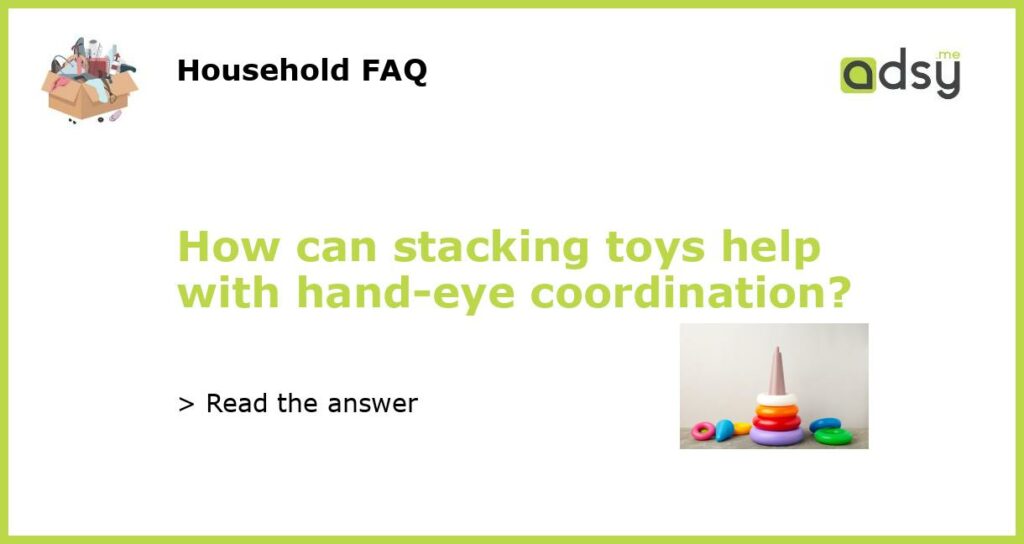What is hand-eye coordination and why is it important?
Hand-eye coordination is the ability to use our eyes to guide our hands in performing tasks. It involves the synchronization of visual and motor skills, allowing us to accurately track and control the movement of our hands in relation to what we see. This skill is essential in everyday activities such as writing, typing, playing sports, and even simple tasks like picking up objects.
Developing good hand-eye coordination enables us to complete tasks efficiently and accurately. It also plays a crucial role in the development of fine motor skills, as well as cognitive and perceptual abilities. Without proper hand-eye coordination, simple activities can become challenging and frustrating. That’s why it is important to nurture and improve this skill from a young age.
How can stacking toys improve hand-eye coordination?
Stacking toys are a valuable tool in developing hand-eye coordination in children. These toys typically consist of various blocks or pieces that can be stacked to create different structures. The process of stacking requires the child to carefully align and position each piece with their hands, while using their eyes to gauge the right placement. This repetitive action helps to train and refine their hand-eye coordination skills.
When a child stacks blocks or pieces, they must use their visual perception to assess the size, shape, and position of each item, and then use their motor skills to execute the movements necessary to place them correctly. This process allows them to practice and improve their hand-eye coordination in a fun and engaging way.
Benefits of using stacking toys for hand-eye coordination development
Using stacking toys has several benefits for hand-eye coordination development:
- Fine motor skill development: Stacking toys require precise movements and manipulation of small objects, which helps in the development of fine motor skills. This is particularly important for young children who are still refining their hand dexterity.
- Visual perception enhancement: Stacking toys encourage children to visually assess the size, shape, and position of each block or piece. This enhances their visual perception abilities and helps them recognize patterns and spatial relationships.
- Concentration and focus: Stacking toys require concentration and focus, as children need to pay attention to details and perform precise movements. Regular practice can improve their ability to concentrate and maintain focus on specific tasks.
- Problem-solving and spatial reasoning: Through stacking toys, children learn to solve problems by figuring out how to balance and position blocks effectively. This promotes spatial reasoning skills and helps them understand concepts of stability and balance.
Tips for using stacking toys effectively
To make the most out of stacking toys for hand-eye coordination development, consider the following tips:
- Start with larger and simpler pieces: Begin with stacking toys that have larger and simpler pieces, such as large blocks. As the child’s hand-eye coordination improves, gradually introduce toys with smaller and more intricate pieces.
- Vary the stacking patterns: Encourage the child to experiment with different ways of stacking the blocks or pieces. This allows them to explore different strategies and develop a deeper understanding of spatial concepts.
- Provide verbal guidance: While playing with stacking toys, provide verbal cues and guidance to help the child understand the concepts of balance, stability, and correct placement. This will enhance their learning experience and help them improve their hand-eye coordination faster.
- Make it a collaborative activity: Stacking toys can also be enjoyed as a collaborative activity. Join in the fun with your child and take turns stacking the pieces. This not only strengthens your bond but also encourages social interaction and cognitive development.
Other activities to promote hand-eye coordination
While stacking toys are excellent tools for improving hand-eye coordination, there are also other activities that can help develop this skill:
- Puzzles: Solving puzzles requires hand-eye coordination as children fit the puzzle pieces together.
- Catching and throwing: Playing catch with a ball helps to improve hand-eye coordination as children track the movement of the ball and position their hands to catch it.
- Drawing and coloring: Holding and manipulating markers or crayons to create drawings helps develop hand-eye coordination.
- Playing musical instruments: Playing instruments such as piano or guitar involves coordinating hand movements with what is seen on sheet music or frets.
By incorporating stacking toys and other activities that promote hand-eye coordination, children can refine this essential skill and improve their overall dexterity and cognitive abilities.






